Entrepreneurial Growth: Strategies, Development, and Exit Plans
VerifiedAdded on 2023/06/16
|9
|1799
|431
Essay
AI Summary
This essay explores the dynamics of entrepreneurial growth, emphasizing the importance of identifying organizational growth cycles and adapting to change. It discusses strategies for various stages, from new ventures to strategic planning, highlighting the significance of organizational structure, leadership, performance management, and corporate culture. The essay also examines the influence of market trends, the advantages and disadvantages of different growth strategies, and the critical role of entry, midlevel, and exit strategies. Furthermore, it delves into niche strategies, the transition from family-based to professionally managed businesses, and the importance of investor relations and exit plans, including acquisitions, mergers, and handling business closures. The essay concludes by underscoring the necessity of strategic planning, employee motivation, and adaptable contingency plans for sustained entrepreneurial success. Desklib provides a platform to access this document, offering valuable insights and acting as a resource for similar assignments.

Entrepreneurship Growth
Paraphrase This Document
Need a fresh take? Get an instant paraphrase of this document with our AI Paraphraser

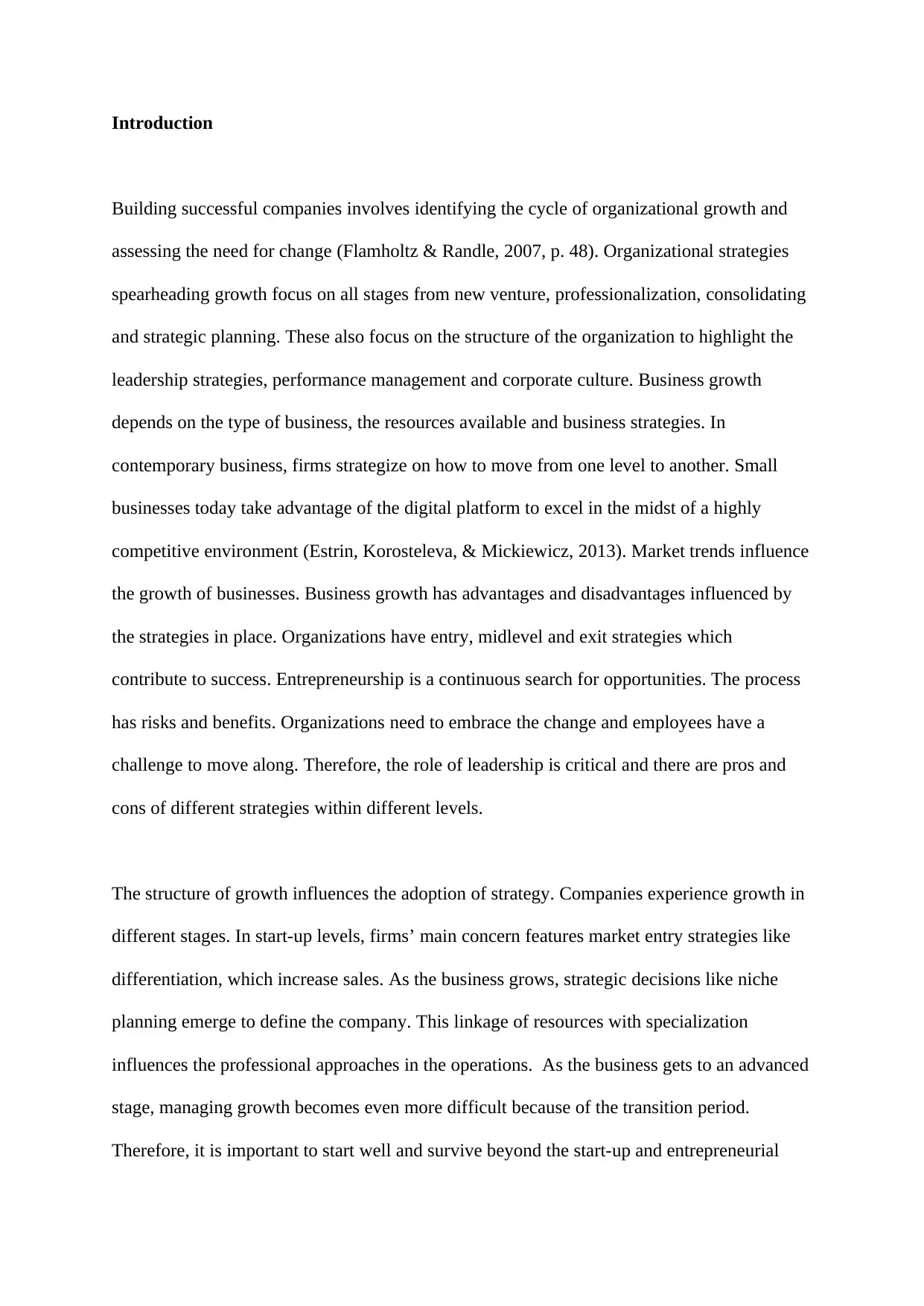
Introduction
Building successful companies involves identifying the cycle of organizational growth and
assessing the need for change (Flamholtz & Randle, 2007, p. 48). Organizational strategies
spearheading growth focus on all stages from new venture, professionalization, consolidating
and strategic planning. These also focus on the structure of the organization to highlight the
leadership strategies, performance management and corporate culture. Business growth
depends on the type of business, the resources available and business strategies. In
contemporary business, firms strategize on how to move from one level to another. Small
businesses today take advantage of the digital platform to excel in the midst of a highly
competitive environment (Estrin, Korosteleva, & Mickiewicz, 2013). Market trends influence
the growth of businesses. Business growth has advantages and disadvantages influenced by
the strategies in place. Organizations have entry, midlevel and exit strategies which
contribute to success. Entrepreneurship is a continuous search for opportunities. The process
has risks and benefits. Organizations need to embrace the change and employees have a
challenge to move along. Therefore, the role of leadership is critical and there are pros and
cons of different strategies within different levels.
The structure of growth influences the adoption of strategy. Companies experience growth in
different stages. In start-up levels, firms’ main concern features market entry strategies like
differentiation, which increase sales. As the business grows, strategic decisions like niche
planning emerge to define the company. This linkage of resources with specialization
influences the professional approaches in the operations. As the business gets to an advanced
stage, managing growth becomes even more difficult because of the transition period.
Therefore, it is important to start well and survive beyond the start-up and entrepreneurial
Building successful companies involves identifying the cycle of organizational growth and
assessing the need for change (Flamholtz & Randle, 2007, p. 48). Organizational strategies
spearheading growth focus on all stages from new venture, professionalization, consolidating
and strategic planning. These also focus on the structure of the organization to highlight the
leadership strategies, performance management and corporate culture. Business growth
depends on the type of business, the resources available and business strategies. In
contemporary business, firms strategize on how to move from one level to another. Small
businesses today take advantage of the digital platform to excel in the midst of a highly
competitive environment (Estrin, Korosteleva, & Mickiewicz, 2013). Market trends influence
the growth of businesses. Business growth has advantages and disadvantages influenced by
the strategies in place. Organizations have entry, midlevel and exit strategies which
contribute to success. Entrepreneurship is a continuous search for opportunities. The process
has risks and benefits. Organizations need to embrace the change and employees have a
challenge to move along. Therefore, the role of leadership is critical and there are pros and
cons of different strategies within different levels.
The structure of growth influences the adoption of strategy. Companies experience growth in
different stages. In start-up levels, firms’ main concern features market entry strategies like
differentiation, which increase sales. As the business grows, strategic decisions like niche
planning emerge to define the company. This linkage of resources with specialization
influences the professional approaches in the operations. As the business gets to an advanced
stage, managing growth becomes even more difficult because of the transition period.
Therefore, it is important to start well and survive beyond the start-up and entrepreneurial
⊘ This is a preview!⊘
Do you want full access?
Subscribe today to unlock all pages.

Trusted by 1+ million students worldwide
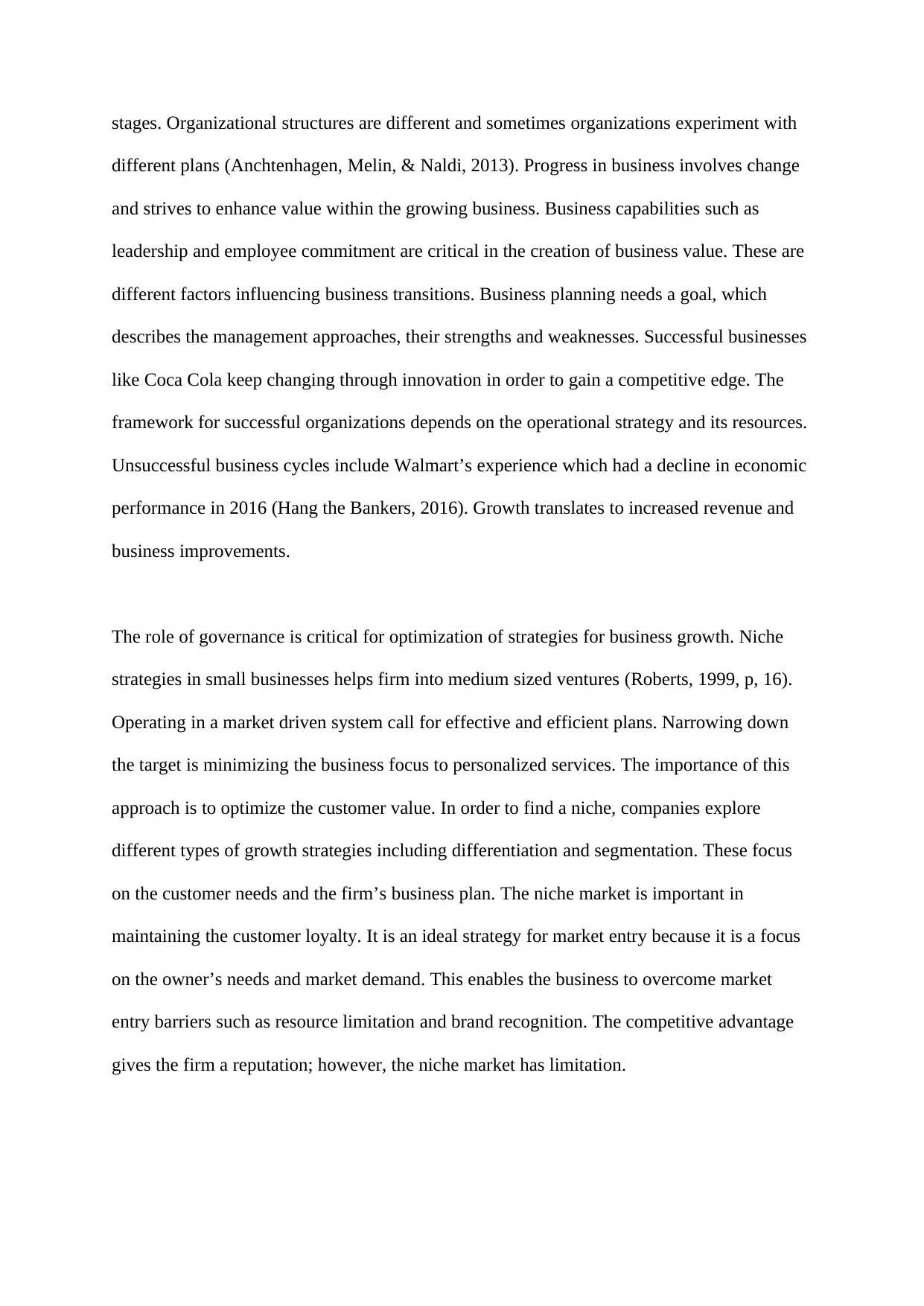
stages. Organizational structures are different and sometimes organizations experiment with
different plans (Anchtenhagen, Melin, & Naldi, 2013). Progress in business involves change
and strives to enhance value within the growing business. Business capabilities such as
leadership and employee commitment are critical in the creation of business value. These are
different factors influencing business transitions. Business planning needs a goal, which
describes the management approaches, their strengths and weaknesses. Successful businesses
like Coca Cola keep changing through innovation in order to gain a competitive edge. The
framework for successful organizations depends on the operational strategy and its resources.
Unsuccessful business cycles include Walmart’s experience which had a decline in economic
performance in 2016 (Hang the Bankers, 2016). Growth translates to increased revenue and
business improvements.
The role of governance is critical for optimization of strategies for business growth. Niche
strategies in small businesses helps firm into medium sized ventures (Roberts, 1999, p, 16).
Operating in a market driven system call for effective and efficient plans. Narrowing down
the target is minimizing the business focus to personalized services. The importance of this
approach is to optimize the customer value. In order to find a niche, companies explore
different types of growth strategies including differentiation and segmentation. These focus
on the customer needs and the firm’s business plan. The niche market is important in
maintaining the customer loyalty. It is an ideal strategy for market entry because it is a focus
on the owner’s needs and market demand. This enables the business to overcome market
entry barriers such as resource limitation and brand recognition. The competitive advantage
gives the firm a reputation; however, the niche market has limitation.
different plans (Anchtenhagen, Melin, & Naldi, 2013). Progress in business involves change
and strives to enhance value within the growing business. Business capabilities such as
leadership and employee commitment are critical in the creation of business value. These are
different factors influencing business transitions. Business planning needs a goal, which
describes the management approaches, their strengths and weaknesses. Successful businesses
like Coca Cola keep changing through innovation in order to gain a competitive edge. The
framework for successful organizations depends on the operational strategy and its resources.
Unsuccessful business cycles include Walmart’s experience which had a decline in economic
performance in 2016 (Hang the Bankers, 2016). Growth translates to increased revenue and
business improvements.
The role of governance is critical for optimization of strategies for business growth. Niche
strategies in small businesses helps firm into medium sized ventures (Roberts, 1999, p, 16).
Operating in a market driven system call for effective and efficient plans. Narrowing down
the target is minimizing the business focus to personalized services. The importance of this
approach is to optimize the customer value. In order to find a niche, companies explore
different types of growth strategies including differentiation and segmentation. These focus
on the customer needs and the firm’s business plan. The niche market is important in
maintaining the customer loyalty. It is an ideal strategy for market entry because it is a focus
on the owner’s needs and market demand. This enables the business to overcome market
entry barriers such as resource limitation and brand recognition. The competitive advantage
gives the firm a reputation; however, the niche market has limitation.
Paraphrase This Document
Need a fresh take? Get an instant paraphrase of this document with our AI Paraphraser
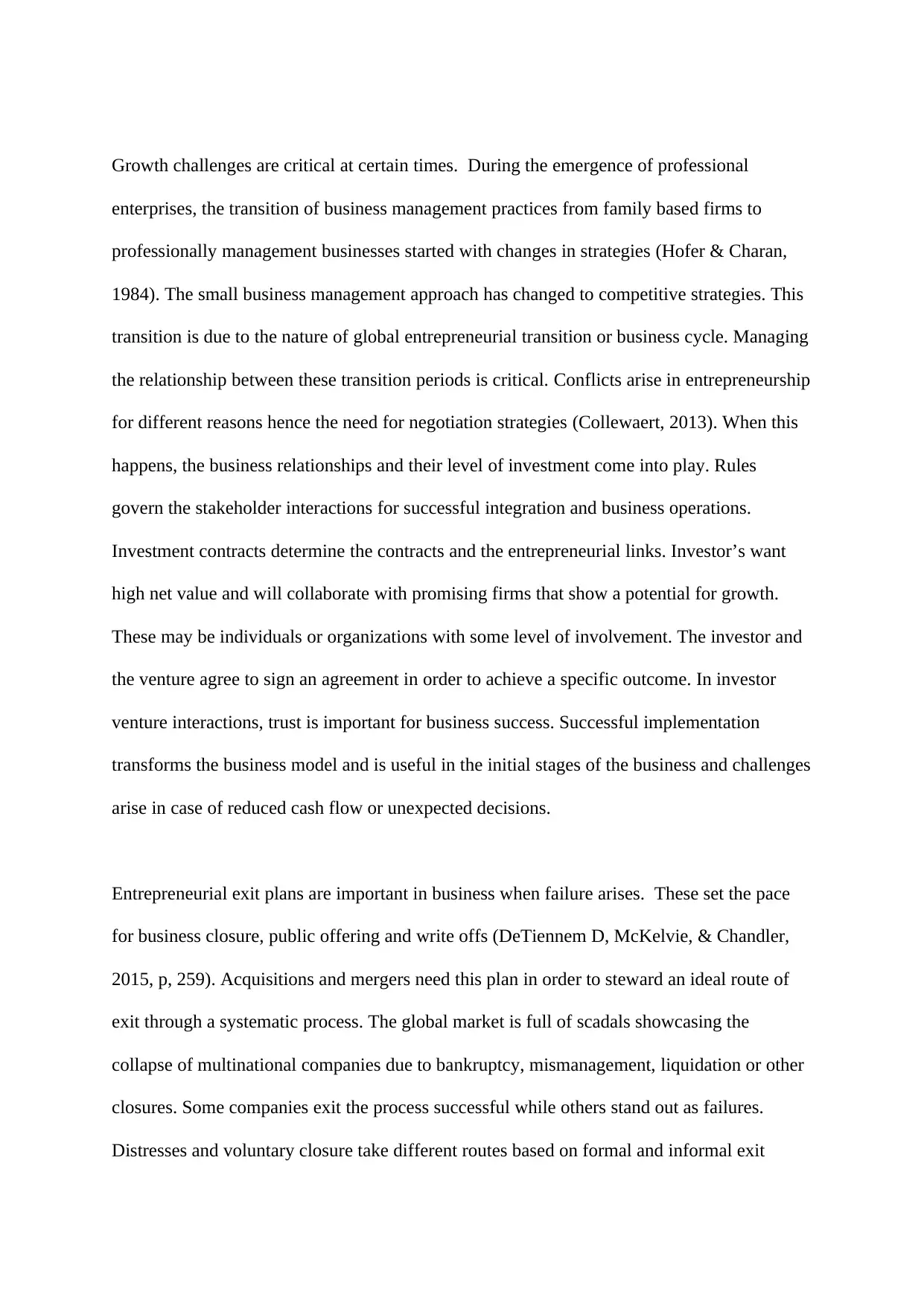
Growth challenges are critical at certain times. During the emergence of professional
enterprises, the transition of business management practices from family based firms to
professionally management businesses started with changes in strategies (Hofer & Charan,
1984). The small business management approach has changed to competitive strategies. This
transition is due to the nature of global entrepreneurial transition or business cycle. Managing
the relationship between these transition periods is critical. Conflicts arise in entrepreneurship
for different reasons hence the need for negotiation strategies (Collewaert, 2013). When this
happens, the business relationships and their level of investment come into play. Rules
govern the stakeholder interactions for successful integration and business operations.
Investment contracts determine the contracts and the entrepreneurial links. Investor’s want
high net value and will collaborate with promising firms that show a potential for growth.
These may be individuals or organizations with some level of involvement. The investor and
the venture agree to sign an agreement in order to achieve a specific outcome. In investor
venture interactions, trust is important for business success. Successful implementation
transforms the business model and is useful in the initial stages of the business and challenges
arise in case of reduced cash flow or unexpected decisions.
Entrepreneurial exit plans are important in business when failure arises. These set the pace
for business closure, public offering and write offs (DeTiennem D, McKelvie, & Chandler,
2015, p, 259). Acquisitions and mergers need this plan in order to steward an ideal route of
exit through a systematic process. The global market is full of scadals showcasing the
collapse of multinational companies due to bankruptcy, mismanagement, liquidation or other
closures. Some companies exit the process successful while others stand out as failures.
Distresses and voluntary closure take different routes based on formal and informal exit
enterprises, the transition of business management practices from family based firms to
professionally management businesses started with changes in strategies (Hofer & Charan,
1984). The small business management approach has changed to competitive strategies. This
transition is due to the nature of global entrepreneurial transition or business cycle. Managing
the relationship between these transition periods is critical. Conflicts arise in entrepreneurship
for different reasons hence the need for negotiation strategies (Collewaert, 2013). When this
happens, the business relationships and their level of investment come into play. Rules
govern the stakeholder interactions for successful integration and business operations.
Investment contracts determine the contracts and the entrepreneurial links. Investor’s want
high net value and will collaborate with promising firms that show a potential for growth.
These may be individuals or organizations with some level of involvement. The investor and
the venture agree to sign an agreement in order to achieve a specific outcome. In investor
venture interactions, trust is important for business success. Successful implementation
transforms the business model and is useful in the initial stages of the business and challenges
arise in case of reduced cash flow or unexpected decisions.
Entrepreneurial exit plans are important in business when failure arises. These set the pace
for business closure, public offering and write offs (DeTiennem D, McKelvie, & Chandler,
2015, p, 259). Acquisitions and mergers need this plan in order to steward an ideal route of
exit through a systematic process. The global market is full of scadals showcasing the
collapse of multinational companies due to bankruptcy, mismanagement, liquidation or other
closures. Some companies exit the process successful while others stand out as failures.
Distresses and voluntary closure take different routes based on formal and informal exit
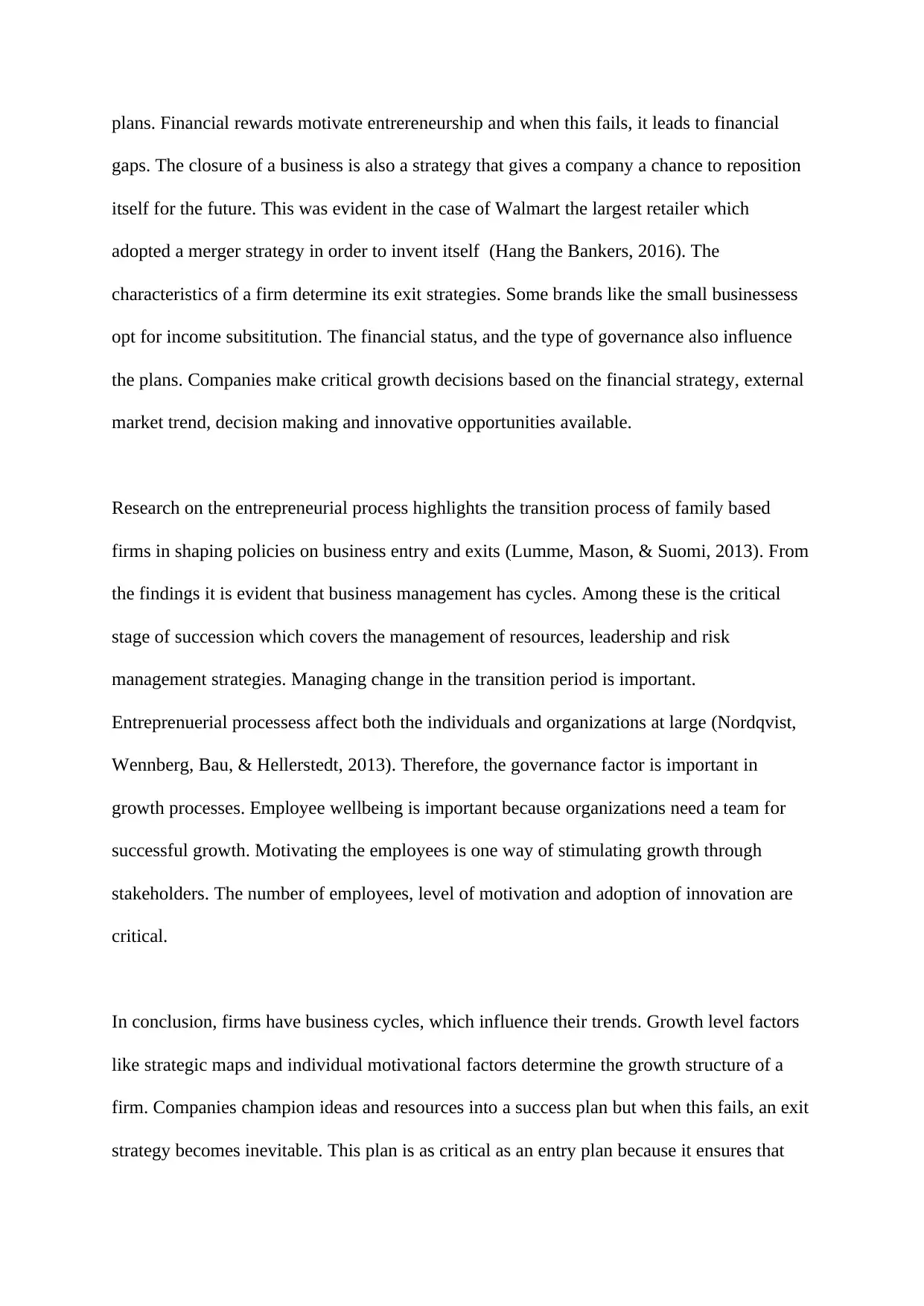
plans. Financial rewards motivate entrereneurship and when this fails, it leads to financial
gaps. The closure of a business is also a strategy that gives a company a chance to reposition
itself for the future. This was evident in the case of Walmart the largest retailer which
adopted a merger strategy in order to invent itself (Hang the Bankers, 2016). The
characteristics of a firm determine its exit strategies. Some brands like the small businessess
opt for income subsititution. The financial status, and the type of governance also influence
the plans. Companies make critical growth decisions based on the financial strategy, external
market trend, decision making and innovative opportunities available.
Research on the entrepreneurial process highlights the transition process of family based
firms in shaping policies on business entry and exits (Lumme, Mason, & Suomi, 2013). From
the findings it is evident that business management has cycles. Among these is the critical
stage of succession which covers the management of resources, leadership and risk
management strategies. Managing change in the transition period is important.
Entreprenuerial processess affect both the individuals and organizations at large (Nordqvist,
Wennberg, Bau, & Hellerstedt, 2013). Therefore, the governance factor is important in
growth processes. Employee wellbeing is important because organizations need a team for
successful growth. Motivating the employees is one way of stimulating growth through
stakeholders. The number of employees, level of motivation and adoption of innovation are
critical.
In conclusion, firms have business cycles, which influence their trends. Growth level factors
like strategic maps and individual motivational factors determine the growth structure of a
firm. Companies champion ideas and resources into a success plan but when this fails, an exit
strategy becomes inevitable. This plan is as critical as an entry plan because it ensures that
gaps. The closure of a business is also a strategy that gives a company a chance to reposition
itself for the future. This was evident in the case of Walmart the largest retailer which
adopted a merger strategy in order to invent itself (Hang the Bankers, 2016). The
characteristics of a firm determine its exit strategies. Some brands like the small businessess
opt for income subsititution. The financial status, and the type of governance also influence
the plans. Companies make critical growth decisions based on the financial strategy, external
market trend, decision making and innovative opportunities available.
Research on the entrepreneurial process highlights the transition process of family based
firms in shaping policies on business entry and exits (Lumme, Mason, & Suomi, 2013). From
the findings it is evident that business management has cycles. Among these is the critical
stage of succession which covers the management of resources, leadership and risk
management strategies. Managing change in the transition period is important.
Entreprenuerial processess affect both the individuals and organizations at large (Nordqvist,
Wennberg, Bau, & Hellerstedt, 2013). Therefore, the governance factor is important in
growth processes. Employee wellbeing is important because organizations need a team for
successful growth. Motivating the employees is one way of stimulating growth through
stakeholders. The number of employees, level of motivation and adoption of innovation are
critical.
In conclusion, firms have business cycles, which influence their trends. Growth level factors
like strategic maps and individual motivational factors determine the growth structure of a
firm. Companies champion ideas and resources into a success plan but when this fails, an exit
strategy becomes inevitable. This plan is as critical as an entry plan because it ensures that
⊘ This is a preview!⊘
Do you want full access?
Subscribe today to unlock all pages.

Trusted by 1+ million students worldwide

the firm’s initiative is not in vain. Companies, which have a fall back plan, stand a high
chance of bouncing back as successful stories despite its shortcomings. Although an exit plan
is a positive move, it does not guarantee a successful bounce back. Therefore, businesses
need proven strategic plans. A customized plan prevents overlapping strategies in order to
help the firm gain a competitive plan. The plan needs to cater for contingency plans to deal
with stakeholders challenges.
References
chance of bouncing back as successful stories despite its shortcomings. Although an exit plan
is a positive move, it does not guarantee a successful bounce back. Therefore, businesses
need proven strategic plans. A customized plan prevents overlapping strategies in order to
help the firm gain a competitive plan. The plan needs to cater for contingency plans to deal
with stakeholders challenges.
References
Paraphrase This Document
Need a fresh take? Get an instant paraphrase of this document with our AI Paraphraser
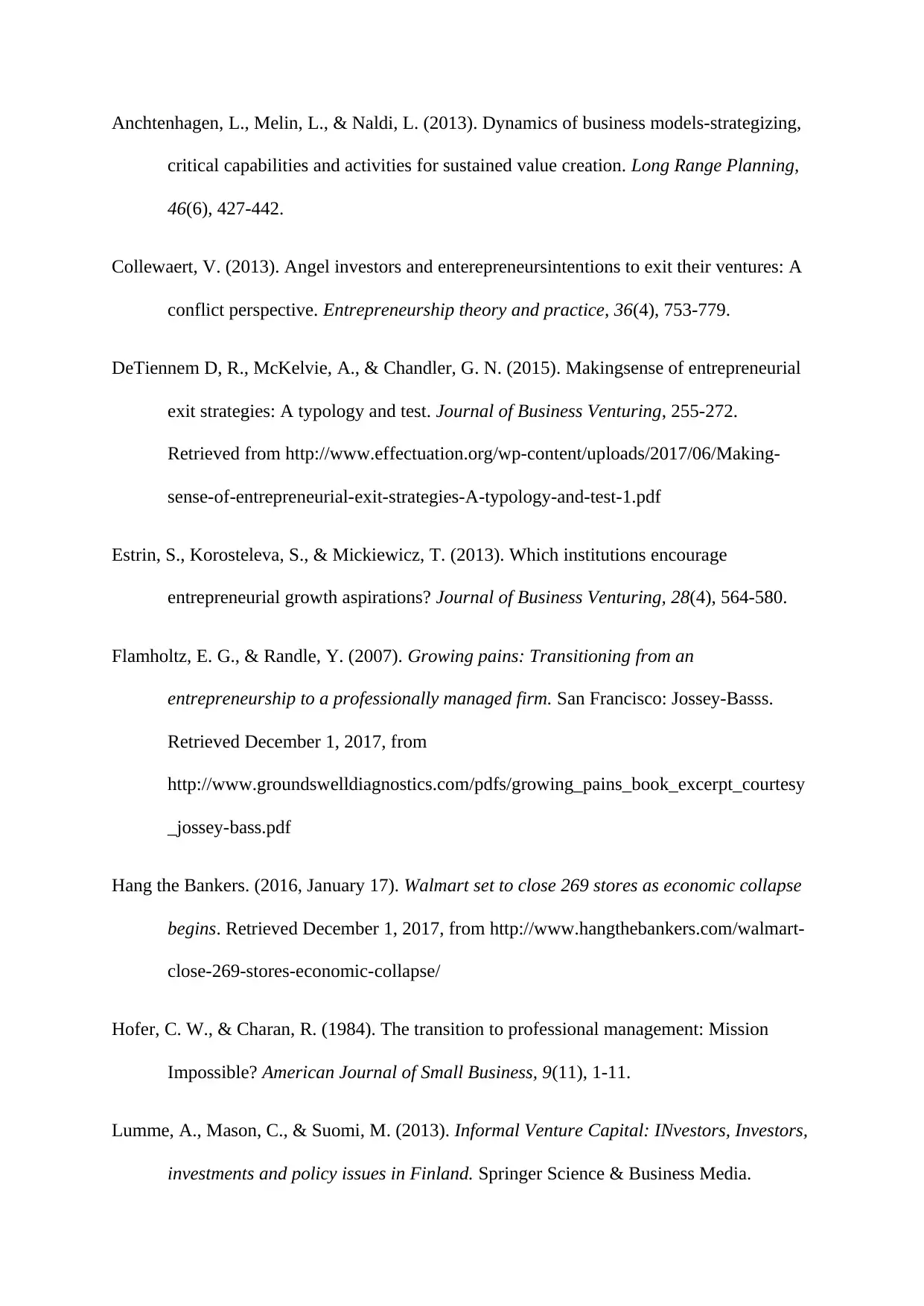
Anchtenhagen, L., Melin, L., & Naldi, L. (2013). Dynamics of business models-strategizing,
critical capabilities and activities for sustained value creation. Long Range Planning,
46(6), 427-442.
Collewaert, V. (2013). Angel investors and enterepreneursintentions to exit their ventures: A
conflict perspective. Entrepreneurship theory and practice, 36(4), 753-779.
DeTiennem D, R., McKelvie, A., & Chandler, G. N. (2015). Makingsense of entrepreneurial
exit strategies: A typology and test. Journal of Business Venturing, 255-272.
Retrieved from http://www.effectuation.org/wp-content/uploads/2017/06/Making-
sense-of-entrepreneurial-exit-strategies-A-typology-and-test-1.pdf
Estrin, S., Korosteleva, S., & Mickiewicz, T. (2013). Which institutions encourage
entrepreneurial growth aspirations? Journal of Business Venturing, 28(4), 564-580.
Flamholtz, E. G., & Randle, Y. (2007). Growing pains: Transitioning from an
entrepreneurship to a professionally managed firm. San Francisco: Jossey-Basss.
Retrieved December 1, 2017, from
http://www.groundswelldiagnostics.com/pdfs/growing_pains_book_excerpt_courtesy
_jossey-bass.pdf
Hang the Bankers. (2016, January 17). Walmart set to close 269 stores as economic collapse
begins. Retrieved December 1, 2017, from http://www.hangthebankers.com/walmart-
close-269-stores-economic-collapse/
Hofer, C. W., & Charan, R. (1984). The transition to professional management: Mission
Impossible? American Journal of Small Business, 9(11), 1-11.
Lumme, A., Mason, C., & Suomi, M. (2013). Informal Venture Capital: INvestors, Investors,
investments and policy issues in Finland. Springer Science & Business Media.
critical capabilities and activities for sustained value creation. Long Range Planning,
46(6), 427-442.
Collewaert, V. (2013). Angel investors and enterepreneursintentions to exit their ventures: A
conflict perspective. Entrepreneurship theory and practice, 36(4), 753-779.
DeTiennem D, R., McKelvie, A., & Chandler, G. N. (2015). Makingsense of entrepreneurial
exit strategies: A typology and test. Journal of Business Venturing, 255-272.
Retrieved from http://www.effectuation.org/wp-content/uploads/2017/06/Making-
sense-of-entrepreneurial-exit-strategies-A-typology-and-test-1.pdf
Estrin, S., Korosteleva, S., & Mickiewicz, T. (2013). Which institutions encourage
entrepreneurial growth aspirations? Journal of Business Venturing, 28(4), 564-580.
Flamholtz, E. G., & Randle, Y. (2007). Growing pains: Transitioning from an
entrepreneurship to a professionally managed firm. San Francisco: Jossey-Basss.
Retrieved December 1, 2017, from
http://www.groundswelldiagnostics.com/pdfs/growing_pains_book_excerpt_courtesy
_jossey-bass.pdf
Hang the Bankers. (2016, January 17). Walmart set to close 269 stores as economic collapse
begins. Retrieved December 1, 2017, from http://www.hangthebankers.com/walmart-
close-269-stores-economic-collapse/
Hofer, C. W., & Charan, R. (1984). The transition to professional management: Mission
Impossible? American Journal of Small Business, 9(11), 1-11.
Lumme, A., Mason, C., & Suomi, M. (2013). Informal Venture Capital: INvestors, Investors,
investments and policy issues in Finland. Springer Science & Business Media.

Nordqvist, M., Wennberg, K., Bau, M., & Hellerstedt, K. (2013). An entrepreneurial process
perspective on succession in family firms. Small Business Economics, 1087-1122.
Retrieved December 1, 2017, from
https://www.researchgate.net/publication/256086846_An_entrepreneurial_process_pe
rspective_on_succession_in_family_firms
Roberts, M. J. (1999). Managing transitions in the growing entreprise. In W. A. Sahlman, &
H. H. Stevenson, The Entrepreneurial Venture (pp. 377-391). Boston, MA: Harvard
Business School. Retrieved December 1, 2017, from
http://www.diva-portal.org/smash/get/diva2:533371/FULLTEXT01.pdf
perspective on succession in family firms. Small Business Economics, 1087-1122.
Retrieved December 1, 2017, from
https://www.researchgate.net/publication/256086846_An_entrepreneurial_process_pe
rspective_on_succession_in_family_firms
Roberts, M. J. (1999). Managing transitions in the growing entreprise. In W. A. Sahlman, &
H. H. Stevenson, The Entrepreneurial Venture (pp. 377-391). Boston, MA: Harvard
Business School. Retrieved December 1, 2017, from
http://www.diva-portal.org/smash/get/diva2:533371/FULLTEXT01.pdf
⊘ This is a preview!⊘
Do you want full access?
Subscribe today to unlock all pages.

Trusted by 1+ million students worldwide
1 out of 9
Related Documents
Your All-in-One AI-Powered Toolkit for Academic Success.
+13062052269
info@desklib.com
Available 24*7 on WhatsApp / Email
![[object Object]](/_next/static/media/star-bottom.7253800d.svg)
Unlock your academic potential
Copyright © 2020–2025 A2Z Services. All Rights Reserved. Developed and managed by ZUCOL.



